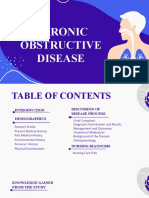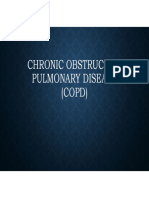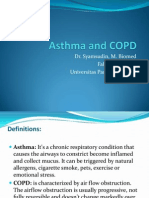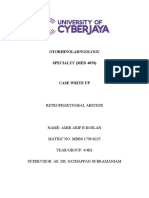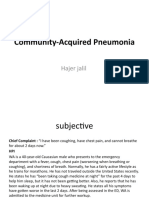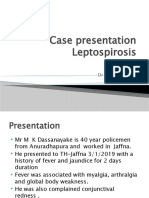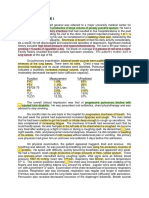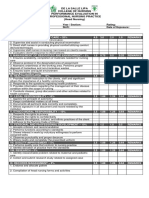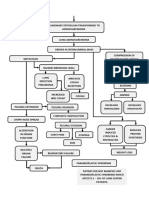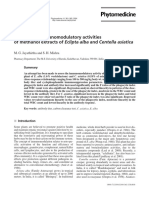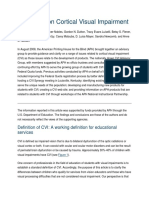Sample Patient Profile
Sample Patient Profile
Uploaded by
Hanako ShigaCopyright:
Available Formats
Sample Patient Profile
Sample Patient Profile
Uploaded by
Hanako ShigaOriginal Description:
Copyright
Available Formats
Share this document
Did you find this document useful?
Is this content inappropriate?
Copyright:
Available Formats
Sample Patient Profile
Sample Patient Profile
Uploaded by
Hanako ShigaCopyright:
Available Formats
Bedside Clinic Guidelines
Pt. Room Number: ER cubicle 4
Patient Name: Mr. J T
Problem / Case: COPD
Brief Patient History
J.T. is a 61 yo man with COPD who presents to the emergency room with a three-day history
of progressive dyspnea, cough, and increased production of clear sputum. He usually coughs
up only a scant amount of clear sputum daily, and coughing is generally worse after rising
in the morning. The patient denies fever, chills, night sweats, weakness, muscle aches, joint
aches, and blood in the sputum. He treated himself with albuterol MDI, but respiratory dis-
tress increased despite multiple inhalations.
Upon arrival at the emergency room, there were few breath sounds heard with auscul-
tation, and the patient was so short of breath that he had difficulty climbing up onto the
examiner’s table and completing a sentence without a long pause. He was placed on 4 L oxy-
gen via nasal cannulae and given nebulized ipratropium and albuterol treatments.
Past Medical History
• HTN x 10 years
• COPD diagnosed 6 years ago
• Occasional episodes of acute bronchitis treated as outpatient with antibiotics
• Mild CVA 4 months ago, appears to have no residual neurologic deficits
• (–) history of TB, occupational exposure, heart disease, or asthma
Laboratory Procedures
Laboratory Blood Test Results
Na 147 meq/L Plt 160 x10 103/mm3 Bilirubin, total 0.3 mg/dL
K 4.1 meq/L WBC 9.1 x10 103/mm3 PT 14.2 sec
Cl 114 meq/L PMNs 62% Alb 4.0 g/dL
HCO3 25 meq/L Lymphs 27% Protein, total 6.8 g/dL
BUN 29 mg/dL Eos 3% Alk phos 78 IU/L
Cr 1.1 mg/dL Basos 1% Ca 8.8 mg/dL
Glu, fasting 98 mg/dL Monos 7% PO4 3.5 mg/dL
Hb 19.3 g/dL AST 14 IU/L Mg 2.5 mg/dL
Hct 55% ALT 31 IU/L AAT 137 mg/dL
Arterial Blood Gases (on 4 L O2 by Cannulae)
• pH 7.32
• PaO2 65 mm Hg
• PaCO2 54 mm Hg
• SaO2 90%
Pulmonary Function Tests
• FEV1 1.67 L (45% of expected)
• FVC 4.10 L (85% of expected)
• FEV1/FVC 0.41 (expected 0.77)
Chest X-Rays
• Hyperinflation with flattened diaphragm
• Large anteroposterior diameter
• Diffuse scarring and bullae in all lung fields but especially prominent in lower lobes bilaterally
• No effusions or infiltrates
• Large pulmonary vasculature
Surgical Management
The patient hasn’t undergone any surgical management.
Pharmacological Management
• HCTZ 25 mg po Q AM
• Amlodipine 5 mg po QD
• Theophylline 200 mg po BID
• Albuterol 180 µg MDI 2 inhalations QID PRN
• Ipratropium 36 µg MDI 2 inhalations QID
• The patient has been compliant with his medications. However, he admits that he does not
like to use ipratropium because it causes “dry mouth” and makes him feel “edgy.”.
Course of Management
The goal of COPD management is to improve a patient’s functional status and quality of life by
preserving optimal lung function; improving symptoms and preventing recurrence of exacerbation.
Smoking cessation greatly decreases episodes of exacerbation. Oxygen therapy also helps to maintain
the patients lung functions. His medications helps control and manage the inflammation and infection
that comes with COPD. Sputum viscosity and Secretion clearance should also be properly managed to
improve symptoms.
Nursing Diagnosis and Management
1. Impaired gas exchange related to decreased lung compliance and altered level of consciousness
as evidenced by dyspnea on exertion.
2. Ineffective airway clearance related to secretions in the bronchi as evidenced by crackles on
auscultation.
3. Disturbed sleep pattern related to breathlessness as evidenced by increasing irritability.
You might also like
- Cramsheet (Exam Cram Nclex PN)Document2 pagesCramsheet (Exam Cram Nclex PN)Katrina Reyes94% (33)
- Vincent Brody Care PlanDocument10 pagesVincent Brody Care PlanKarina Rodriguez50% (2)
- Lab09 Therapy4 IronDeficiencyDocument5 pagesLab09 Therapy4 IronDeficiencyHayna Rose100% (1)
- Pulmonology Step2 CKDocument22 pagesPulmonology Step2 CKsarwat86% (7)
- ACUTE AND CHRONIC PANCREATITIS-undoneDocument6 pagesACUTE AND CHRONIC PANCREATITIS-undonecory kurdapyaNo ratings yet
- Ketidakseimbangan Elektrolit (Corat Coret)Document5 pagesKetidakseimbangan Elektrolit (Corat Coret)jendal_kancilNo ratings yet
- Community Medicine Last Moment RevisionsDocument17 pagesCommunity Medicine Last Moment RevisionsDeepak Maini100% (2)
- Chronic Obstructive Pulmonary Disease: Presented byDocument25 pagesChronic Obstructive Pulmonary Disease: Presented byChinni 12599No ratings yet
- Asthma Treatment GuidlineDocument56 pagesAsthma Treatment GuidlineEsther OdumanyeNo ratings yet
- An Interesting Case of Unresolved PneumoniaDocument40 pagesAn Interesting Case of Unresolved PneumoniaJeevankumar DommarajuNo ratings yet
- Niall Cosgrave Email: Ncosgrav@Tcd - IeDocument24 pagesNiall Cosgrave Email: Ncosgrav@Tcd - IeSaoirse MorrinNo ratings yet
- Copd 2022Document45 pagesCopd 2022Mubassir NisarNo ratings yet
- Case Presentation ETD (COPD)Document45 pagesCase Presentation ETD (COPD)Dzachary13No ratings yet
- COPDDocument49 pagesCOPDArmoured SpartanNo ratings yet
- Copd NatsDocument47 pagesCopd NatsKristen Nathany MalapitNo ratings yet
- Pals Presentation (1) - UpdatedDocument22 pagesPals Presentation (1) - UpdatedHamza JamalNo ratings yet
- Ibrahim Rawhi Ayasreh - Case PresentationDocument41 pagesIbrahim Rawhi Ayasreh - Case PresentationIbrahim R. AyasrehNo ratings yet
- COPD Therapeutics CaseDocument34 pagesCOPD Therapeutics CaseCindy NoufalNo ratings yet
- Blok KGD Pemicu 7Document93 pagesBlok KGD Pemicu 7LuzjrNo ratings yet
- Case Based CCNDocument36 pagesCase Based CCNKeep smileNo ratings yet
- Patient Prep: Follow Guidelines On P. 65 of Clinical PacketDocument4 pagesPatient Prep: Follow Guidelines On P. 65 of Clinical PacketKatherine AmbrosiaNo ratings yet
- Crypto C CocusDocument26 pagesCrypto C CocusBrinna Anindita SatriaNo ratings yet
- Acute Pancreatitis Case PresDocument29 pagesAcute Pancreatitis Case Preskristine keen buan100% (1)
- Acute AppendicitisDocument6 pagesAcute Appendicitiscuka suka jerpNo ratings yet
- Case Study RSsp2010Document18 pagesCase Study RSsp2010harvey63No ratings yet
- CLD With MeningitisDocument18 pagesCLD With MeningitisMhd AloofNo ratings yet
- Case-Based Learning Thoracic Medicine: Chronic Obstructive Pulmonary DiseaseDocument22 pagesCase-Based Learning Thoracic Medicine: Chronic Obstructive Pulmonary DiseaseAnonymous HNTNhspNo ratings yet
- PneumoniaDocument69 pagesPneumoniaHamna ZainabNo ratings yet
- Chronic Obstructive Pulmonary Disease (COPD)Document32 pagesChronic Obstructive Pulmonary Disease (COPD)MK KNo ratings yet
- Asma Dan Penyakit Paru Obstruktif KronisDocument34 pagesAsma Dan Penyakit Paru Obstruktif KronisAtikah ArifahNo ratings yet
- Ha Noi Medical Universit1Document15 pagesHa Noi Medical Universit1Thảo LÊNo ratings yet
- Chronic Obstructive Pulmonary Disease: by Abhinay Sharma Bhugoo Ml-610Document62 pagesChronic Obstructive Pulmonary Disease: by Abhinay Sharma Bhugoo Ml-610abhinay_1712No ratings yet
- Final DraftDocument6 pagesFinal DraftSimon KingNo ratings yet
- Chronic Obstructive Pulmonary DiseaseDocument29 pagesChronic Obstructive Pulmonary DiseasesivaNo ratings yet
- Laki-Laki, 21 Tahun Dengan Ketoasidosis DiabetikumDocument66 pagesLaki-Laki, 21 Tahun Dengan Ketoasidosis DiabetikumAnonymous gudRSKNo ratings yet
- Anaesthesia For Patients With COPD: University College of Medical Sciences & GTB Hospital, DelhiDocument76 pagesAnaesthesia For Patients With COPD: University College of Medical Sciences & GTB Hospital, DelhiRINI100% (1)
- COPD Case PresentationDocument66 pagesCOPD Case PresentationAzima Abdelrhaman100% (5)
- Hospital Case PneumothoraxDocument9 pagesHospital Case PneumothoraxJohn Rendel LopezNo ratings yet
- Chronic Obstructive Lung Disease (COPD) : Is An Obstructive Lung Diseases in Which Irreversible Lung Damage Has OccuredDocument25 pagesChronic Obstructive Lung Disease (COPD) : Is An Obstructive Lung Diseases in Which Irreversible Lung Damage Has OccuredOmar AbdillahiNo ratings yet
- Case Scenario BronchitisDocument4 pagesCase Scenario BronchitisJamelyn AsuncionNo ratings yet
- Rat PoisonDocument41 pagesRat Poisonkhizra mumtazNo ratings yet
- Arif's Ent CwuDocument16 pagesArif's Ent CwuAmir ArifNo ratings yet
- Community-Acquired PneumoniaDocument10 pagesCommunity-Acquired PneumoniaHajir AldahhanNo ratings yet
- Case Presentation LeptoDocument16 pagesCase Presentation LeptoMalaka AtapattuNo ratings yet
- Respi - Copd Report 2018Document46 pagesRespi - Copd Report 2018April Mae Magos LabradorNo ratings yet
- Vulnus Ictum: Dr. Jeremia SamosirDocument64 pagesVulnus Ictum: Dr. Jeremia SamosirjerryNo ratings yet
- ARDSDocument28 pagesARDSKAMLESH RATHODNo ratings yet
- Organophosphate PoisoningDocument22 pagesOrganophosphate Poisoningatiyasimon2020No ratings yet
- 16 Martie - Curs BPOC - SlideDocument95 pages16 Martie - Curs BPOC - Slidejonah1024No ratings yet
- Cystic Fibrosis: Prepared By: Johanna PepitoDocument38 pagesCystic Fibrosis: Prepared By: Johanna PepitoDharrenceNo ratings yet
- Cough: Diagnosis and ManagementDocument65 pagesCough: Diagnosis and Managementsonu_23No ratings yet
- Case Presentation On Chronic BronchitisDocument20 pagesCase Presentation On Chronic BronchitisSafoora Rafeeq100% (1)
- Chronic Obstructive Pulmonary Disease (COPD) - Causes, Clinical Features, Treatment, Diagnosis, and ComplicationsDocument6 pagesChronic Obstructive Pulmonary Disease (COPD) - Causes, Clinical Features, Treatment, Diagnosis, and ComplicationsSagar YadavNo ratings yet
- Purnachandrao Death PPT FINALDocument38 pagesPurnachandrao Death PPT FINALkalyanpavuralaNo ratings yet
- Anesthesia For Laparoscopic Myomectomy (LM)Document25 pagesAnesthesia For Laparoscopic Myomectomy (LM)東廣謀No ratings yet
- Delayed Emergence in Post Anesthesia Care Unit (Pacu) : Achmed RizalDocument15 pagesDelayed Emergence in Post Anesthesia Care Unit (Pacu) : Achmed RizalAdikurniawanNo ratings yet
- Case Study Presentation: Chronic Obstructive Pulmonary Disease CopdDocument5 pagesCase Study Presentation: Chronic Obstructive Pulmonary Disease CopdHusaifah BaliwanNo ratings yet
- Pre Fellows Orals JR 2023 (2) With AnswersDocument4 pagesPre Fellows Orals JR 2023 (2) With AnswersTina KawNo ratings yet
- Integrative Case IDocument3 pagesIntegrative Case IYani ManuelNo ratings yet
- IMED Case 1-1Document6 pagesIMED Case 1-1Shakshi RainaNo ratings yet
- CardioDocument24 pagesCardiokalyanpavuralaNo ratings yet
- De La Salle Lipa College of Nursing Performance Evaluation in Professional Nursing Practice (Head Nursing)Document2 pagesDe La Salle Lipa College of Nursing Performance Evaluation in Professional Nursing Practice (Head Nursing)Hanako ShigaNo ratings yet
- Linda Bayless, APRN-C, ACNP, FNP, CNRNDocument95 pagesLinda Bayless, APRN-C, ACNP, FNP, CNRNHanako ShigaNo ratings yet
- Med SurgDocument3 pagesMed SurgHanako ShigaNo ratings yet
- Decreased Hematocrit Decreased HemoglobinDocument1 pageDecreased Hematocrit Decreased HemoglobinHanako ShigaNo ratings yet
- PATHOPHYSIOLOGY - Adenocarcinoma of The Lungs: - Diet - Smoking - Environmental - Age - Gender - SexDocument1 pagePATHOPHYSIOLOGY - Adenocarcinoma of The Lungs: - Diet - Smoking - Environmental - Age - Gender - SexHanako ShigaNo ratings yet
- Nocturnal Emissions: "Wet Dreams"Document10 pagesNocturnal Emissions: "Wet Dreams"Hanako Shiga100% (1)
- Cystatin: What Is Its RoleDocument8 pagesCystatin: What Is Its RolecmeytasNo ratings yet
- Heart Failure Case NewDocument7 pagesHeart Failure Case NewMonnaa Al soultanNo ratings yet
- Thoracentesis NEJMDocument4 pagesThoracentesis NEJMKTNBNo ratings yet
- Reading On MeaslesDocument4 pagesReading On MeaslesHUSAIN, HAIZIAH-YASMINNo ratings yet
- Gel Formulation of Drug X Drug and Evaluate Its EfficacyDocument26 pagesGel Formulation of Drug X Drug and Evaluate Its EfficacyPriyanka YadavNo ratings yet
- CHN Practice Exam 1Document7 pagesCHN Practice Exam 1Domeyeg, Clyde Mae W.100% (1)
- Cardiovascular DiseasesDocument8 pagesCardiovascular DiseasesRebecca MarshallNo ratings yet
- CannabinoidsDocument9 pagesCannabinoidsapi-706239751No ratings yet
- Final Group One BBD PresentationDocument63 pagesFinal Group One BBD Presentationsamuel mergaNo ratings yet
- Running Head: SCIENCE 1Document3 pagesRunning Head: SCIENCE 1Migo IringanNo ratings yet
- Crush Step 1 ErrataDocument8 pagesCrush Step 1 ErrataShirkeInc100% (1)
- Power Point ICD 10Document29 pagesPower Point ICD 10vparanjpeNo ratings yet
- Unit-III HFNDocument52 pagesUnit-III HFNSachin ShrivastavNo ratings yet
- 7 Benefits and Uses of CBD Oil (Plus Side Effects) : NutritionDocument18 pages7 Benefits and Uses of CBD Oil (Plus Side Effects) : NutritionAnonymous yCpjZF1rFNo ratings yet
- Pedia BADocument72 pagesPedia BABabbie CasinNo ratings yet
- Komal RTPCRDocument2 pagesKomal RTPCRUppili PranavaneNo ratings yet
- Preliminary Immunomodulatory Activities of Methanol Extracts of Eclipta Alba and Centella AsiaticaDocument5 pagesPreliminary Immunomodulatory Activities of Methanol Extracts of Eclipta Alba and Centella AsiaticaMinyty LeNo ratings yet
- Endodontic Mishaps: IDocument9 pagesEndodontic Mishaps: IMariyam AnzilNo ratings yet
- CentralVenousCatheter CVCDocument41 pagesCentralVenousCatheter CVCPraveen RavishankaranNo ratings yet
- Untitled DocumentDocument12 pagesUntitled DocumentCris Juev Jonathan RecayoNo ratings yet
- Guidelines For The Diagnosis and Therapy of The Vein and Lymphatic DisordersDocument98 pagesGuidelines For The Diagnosis and Therapy of The Vein and Lymphatic Disordersnazar shekhoNo ratings yet
- Cochrane: LibraryDocument70 pagesCochrane: Libraryskola onlajnNo ratings yet
- Cell Receptor Lab: Adapted From Andrew Henriksen, Amityville Memorial High SchoolDocument7 pagesCell Receptor Lab: Adapted From Andrew Henriksen, Amityville Memorial High SchoolLilianna PadroNo ratings yet
- A Review Immuno Oncology Agents For Cancer TherapyDocument8 pagesA Review Immuno Oncology Agents For Cancer TherapyResearch ParkNo ratings yet
- Oxford Textbook of Medicine 2 6nbsped 9780198746690 CompressDocument1,873 pagesOxford Textbook of Medicine 2 6nbsped 9780198746690 CompressNeurobites ESL100% (1)
- Final Exam - Best, Sample ExamDocument8 pagesFinal Exam - Best, Sample ExamSolomonNo ratings yet
- Statement On Cortical Visual ImpairmentDocument14 pagesStatement On Cortical Visual ImpairmentAmal AlmutiriNo ratings yet














